Source code for mrinversion.kernel.utils
# -*- coding: utf-8 -*-
import numpy as np
[docs]def x_y_to_zeta_eta(x, y):
r"""Convert the coordinates :math:`(x,y)` to :math:`(\zeta, \eta)` using the
following definition,
.. math::
\left.\begin{array}{rl}
\zeta &= \sqrt{x^2 + y^2}, \\
\eta &= \frac{4}{\pi} \tan^{-1} \left| \frac{x}{y} \right|
\end{array} {~~~~~~~~} \right\} {~~~~~~~~} |x| \le |y|.
.. math::
\left.\begin{array}{rl}
\zeta &= -\sqrt{x^2 + y^2}, \\
\eta &= \frac{4}{\pi} \tan^{-1} \left| \frac{y}{x} \right|
\end{array} {~~~~~~~~} \right\} {~~~~~~~~} |x| > |y|.
Args:
x: floats or Quantity object. The coordinate x.
y: floats or Quantity object. The coordinate y.
Return:
A list of two ndarrays. The first array is the :math:`\zeta`
coordinates. The second array is the :math:`\eta` coordinates.
"""
x_unit = y_unit = 1
if x.__class__.__name__ == "Quantity":
x_unit = x.unit
x = x.value
if y.__class__.__name__ == "Quantity":
y_unit = y.unit
y = y.value
if x_unit != y_unit:
raise ValueError(
f"x and y must have same dimensionality; x ({x_unit}) != y ({y_unit})."
)
zeta = np.sqrt(x ** 2 + y ** 2) # + offset
eta = 1.0
if x > y:
zeta = -zeta
eta = (4.0 / np.pi) * np.arctan(y / x)
if x < y:
eta = (4.0 / np.pi) * np.arctan(x / y)
return zeta * x_unit, eta
def _x_y_to_zeta_eta(x, y):
"""Same as def x_y_to_zeta_eta, but for ndarrays."""
x = np.abs(x)
y = np.abs(y)
zeta = np.sqrt(x ** 2 + y ** 2) # + offset
eta = np.ones(zeta.shape)
index = np.where(x > y)
zeta[index] = -zeta[index]
eta[index] = (4.0 / np.pi) * np.arctan(y[index] / x[index])
index = np.where(x < y)
eta[index] = (4.0 / np.pi) * np.arctan(x[index] / y[index])
return zeta.ravel(), eta.ravel()
[docs]def zeta_eta_to_x_y(zeta, eta):
r"""Convert the coordinates :math:`(\zeta,\eta)` to :math:`(x, y)` using the
following definition,
.. math::
\left. \begin{array}{rl}
x &= |\zeta| \sin\theta, \\
y &= |\zeta| \cos\theta
\end{array} {~~~~~~~~} \right\} {~~~~~~~~} \zeta \ge 0
.. math::
\left. \begin{array}{rl}
x &= |\zeta| \cos\theta, \\
y &= |\zeta| \sin\theta
\end{array} {~~~~~~~~} \right\} {~~~~~~~~} \zeta < 0
where :math:`\theta = \frac{\pi}{4}\eta`.
Args:
x: ndarray or list of floats. The coordinate x.
y: ndarray or list of floats. The coordinate y.
Return:
A list of ndarrays. The first array holds the coordinate :math:`x`. The
second array holds the coordinates :math:`y`.
"""
zeta = np.asarray(zeta)
eta = np.asarray(eta)
theta = np.pi * eta / 4.0
x = np.zeros(zeta.size)
y = np.zeros(zeta.size)
index = np.where(zeta >= 0)
x[index] = zeta[index] * np.sin(theta[index])
y[index] = zeta[index] * np.cos(theta[index])
index = np.where(zeta < 0)
x[index] = -zeta[index] * np.cos(theta[index])
y[index] = -zeta[index] * np.sin(theta[index])
return x.ravel(), y.ravel()
def _x_y_to_zeta_eta_distribution(grid, supersampling):
"""Return a list of zeta-eta coordinates from a list of x-y coordinates."""
# if grid.x.coordinates_offset != grid.y.coordinates_offset:
# raise ValueError("coordinates_offset for x and y grid must be identical")
x_coordinates = _supersampled_coordinates(grid[0], supersampling=supersampling)
y_coordinates = _supersampled_coordinates(grid[1], supersampling=supersampling)
if x_coordinates.unit.physical_type == "frequency":
x_coordinates = x_coordinates.to("Hz").value
y_coordinates = y_coordinates.to("Hz").value
# offset = grid.x.coordinates_offset.to("Hz").value
elif x_coordinates.unit.physical_type == "dimensionless":
x_coordinates = x_coordinates.to("ppm").value
y_coordinates = y_coordinates.to("ppm").value
# x_coordinates = (x_coordinates * dimension.larmor_frequency).to("").value
# y_coordinates = (y_coordinates * dimension.larmor_frequency).to("").value
# offset = grid.x.coordinates_offset.to("").value
x_mesh, y_mesh = np.meshgrid(
np.abs(x_coordinates), np.abs(y_coordinates), indexing="xy"
)
# y_offset = y_coordinates[0]
# x_offset = x_coordinates[0]
return _x_y_to_zeta_eta(x_mesh, y_mesh)
def _supersampled_coordinates(dimension, supersampling=1):
r"""The coordinates along the dimension.
Args:
supersampling: An integer used in supersampling the coordinates along the
dimension, If :math:`n` is the count, :math:`\Delta_x` is the increment,
:math:`x_0` is the coordinates offset along the dimension, and :math:`m` is
the supersampling factor, a total of :math:`mn` coordinates are sampled
using
.. math::
x = [0 .. (nm-1)] \Delta_x + \x_0 - \frac{1}{2} \Delta_x (m-1)
where :math:`\Delta_x' = \frac{\Delta_x}{m}`.
Returns:
An `Quantity` array of coordinates.
"""
array = dimension.coordinates
if dimension.type == "linear":
increment = dimension.increment / supersampling
array = np.arange(dimension.count * supersampling) * increment
array += dimension.coordinates_offset
# shift the coordinates by half a bin for proper averaging
array -= 0.5 * increment * (supersampling - 1)
return array
